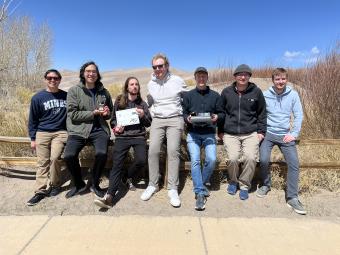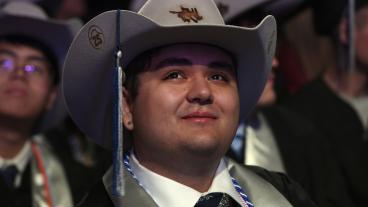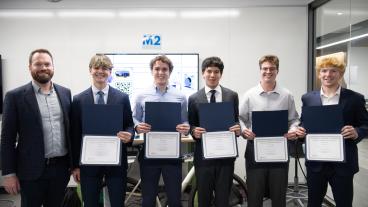Mines Robotics Team wins NASA-funded competition

The Mines Robotics Club won best robot in the under one-and-a-half-kilogram weight class at the Colorado Space Grant Consortium competition, held at Great Sand Dunes National Park and Preserve in southern Colorado.
Teams competing were required to create an autonomous rover that can drive through a Martian-like environment. Because the Mines team has competed before, the strategy for this year’s competition was to try something different from the same designs they’d seen before.
“This year we wanted to have a really innovative robot on both the hardware and software side,” said Nathan Woo, president of the Mines Robotics Club.
One of the big changes to this year’s robot was taking the wheels off – literally. The team replaced the standard four-wheel design with a screw drive, which pushes sand out of the way.
“In previous years, we had a four-wheel design, and everybody had a four-wheel design,” Woo said. “We wanted to have a unique drive system this year. The screw drive allows us to move forward, backward, left and right and allows us to strafe.”
Also different this year was how the team approached the robot’s software.
“Last year, we saw many teams were using an ultrasonic sensor, which simply scans to see if anything is in front and then moves around it,” Woo said. “We wanted ours to be more complex than that, so we used cameras and computer vision to fully detect objects using machine learning and navigate around them using pathfinding algorithms.”
Changing up the standard design proved useful, because the day of the competition, they faced an unforeseen hurdle they had to overcome to be successful. The dunes had been covered in snow the day before, so the sand was wet and very soft. After spending a few hours debugging and working out the kinks, the team figured out how to have the robot move sideways and complete the competition’s courses. The team hadn’t been able to see the courses either beforehand, so they went into the competition knowing to be prepared for anything.
“The team came up with that idea [to drive sideways] after seeing the conditions, which is really what we’re proud of, because we’re not able to expect everything and test every single aspect, especially the conditions on the day,” Woo said. “We’re super happy to have been able to work around that in an effective way.”
The Mines Robotics Club, which has about 100 members, ended up split into two teams for the competition, with half working on the smaller, innovatively designed robot (which ended up winning their weight class at the competition) and another half creating a larger, more robust robot designed similarly to robots created by other teams. Teams were divided depending on students’ majors, providing mechanical, electrical and software support for each design. Phd Student Justin Davis was the winning team’s overall leader, Daniel Abel ‘23 lead the innovative mechanical design and Alex Nesbitt ‘23 led the electrical subsystem.
Woo said the assistance the team received from different departments at Mines was crucial to their success. The Space Resources Department funded their trip to the competition, as well as offering advice, while Robotics offered design review.
The team didn’t take a break after winning the NASA competition. In April, they also competed at a robotics battlebots competition in New Mexico – and they won first and second place at that contest as well.




